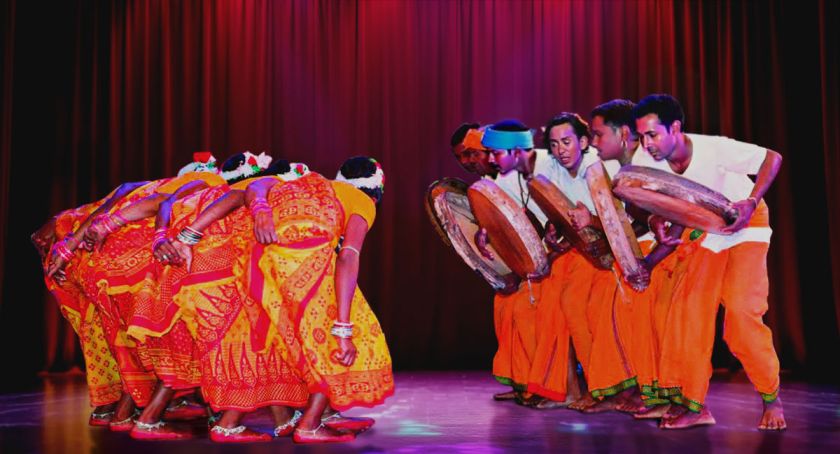Changu folk Dance of Odisha
Changu Dance is a vibrant folk dance of Odisha, deeply rooted in the traditions of its indigenous communities. The Bhuyan, Gond, and Kondh tribes perform this dance, named after the Changu, a single-membrane percussion instrument. It embodies joy, celebration, and spirituality, often marking festivals and significant social gatherings. With rhythmic beats and synchronized movements, Changu Dance captivates audiences while preserving the rich cultural heritage of Odisha’s tribal communities. The dancers’ colorful attire, expressive gestures, and energetic footwork make it a spectacle. Changu Dance thrives across generations as a symbol of unity and tradition.
The Essence of Changu Dance
Changu Dance derives its name from the Changu, a small, single-membrane percussion instrument that plays a crucial role in the performance. The Bhuyan, Gond, and Kondh tribes predominantly dance in the hilly regions of Odisha. For these tribal groups, Changu is not just a dance but a symbol of joy, celebration, and devotion.
It is known for its energy, rhythm, and synchronization. Unlike classical dances that follow structured movements, Changu Dance is more spontaneous and deeply rooted in the everyday life and spiritual beliefs of these tribal communities. It is performed during important ceremonies and festivals, making it an integral part of their social fabric. Audiences are enthralled by the captivating spectacle produced by the dancers’ quick and elegant movements and the rhythmic rhythms of the Changu instrument.
Roots and Heritage
Ancient tribal communities established Changu Dance, integrating music and dance into their social and religious gatherings. They performed this dance to invoke blessings from deities and celebrate successful harvests. Over time, it evolved into a distinct cultural expression that thrived through generations.
For centuries, dance and music have played an essential role in the tribal way of life. People used them to mark important occasions, such as the change of seasons, religious rituals, and rites of passage. Changu Dance is an example of how tribal communities have preserved their heritage through performance arts. Despite external influences and modernization, the dance has remained relatively unchanged.
Unique Features of Changu Dance
One of the most fascinating aspects of Changu Dance is its synchronized movements and rhythmic beats. Dancers, mainly women, form a circle and move gracefully to the rhythmic beats of the Changu, while men play the instrument. Their swift and energetic footwork and expressive facial gestures create a mesmerizing spectacle.
Songs that are frequently influenced by nature, everyday life, and tradition are performed by tribal musicians to accompany the dance. The performance is incredibly captivating since the lyrics tell tales of dedication, love, and bravery. Because they frequently sing about woods, rivers, animals, and heavenly bodies, the songs also demonstrate the tribal people’s affinity to nature. These performances serve as a conduit for cultural transmission and storytelling within the community.
Attire and Accessories Worn by the Performers
The dancers wear traditional tribal attire, including colorful sarees, beaded necklaces, and silver ornaments. Their elaborate headgear and floral decorations add to the dance’s visual appeal. Their clothing’s bright colors and complex designs symbolize joy and festivity.
The male performers who play the Changu often wear simple dhotis with turbans, reflecting their cultural identity. The accessories and attire enhance the dance’s visual impact, making it even more captivating for the audience.
Occasions and Festivals Featuring
It is a prominent feature in tribal festivals and community celebrations. Dancers perform it during significant occasions such as Karma Puja, Maghe Parab, and Sarhul, which Odisha’s tribal communities enthusiastically celebrate. These festivals preserve and promote the rich heritage of Changu Dance.
During these celebrations, the entire community participates in and witnesses the dance. The performances create an atmosphere of unity and festivity, reinforcing social bonds and ensuring that traditional customs continue to be practiced by future generations.
Bringing Changu Dance to the World Stage
It is a regional art form that shows India’s rich tribal heritage. Its energetic performances, cultural depth, and vibrant expressions make it a dance that deserves global recognition. By promoting this dance on digital platforms and cultural festivals, we can ensure that this age-old tradition continues to flourish.
International exposure can also lead to cross-cultural appreciation and collaboration. For example, dance troupes from Odisha can participate in global folk festivals, allowing the world to witness the beauty of Changu Dance. Additionally, cultural exchanges can foster a deeper understanding of India’s indigenous traditions.
Conclusion
Changu Dance of Odisha is more than just a dance; it expresses life, joy, and tradition. Its lively beats, captivating movements, and deep cultural roots make it a cherished part of Odisha’s heritage. As people intensify efforts to preserve and promote it, this unique dance form will gain even greater recognition, securing its place in traditional performing arts.
By valuing and supporting Changu Dance, we contribute to preserving India’s diverse tribal heritage. Whether through local festivals, academic studies, or digital outreach, every effort helps keep this vibrant dance alive for generations. It celebrates tradition, is a testament to resilience, and beautifully expresses Odisha’s rich cultural legacy.


